|
< Earlier Kibitzing · PAGE 2 OF 2 ·
Later Kibitzing> |
| Oct-22-16 | | Once: Well, yes, it does like a tad easy for a Saturday. White sets up a "bounce" tactic to set up connected passed pawns. What is a bounce? I'm glad you asked. A bounce is when we temporarily transform the game of chess into the game of draughts or chequers. We play a move that forces our opponent to respond and that gives us the time to play another move. And sometimes another. So after 36. Rxd6 Kxd6 we get to here:
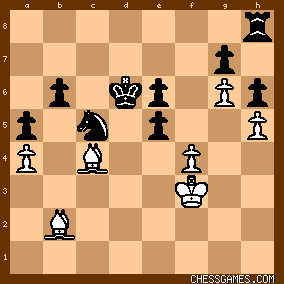
click for larger viewAnd now we can play Bxe5+ (king moves - BOUNCE), Bxg7 (rook moves - BOUNCE) and Bxh6. 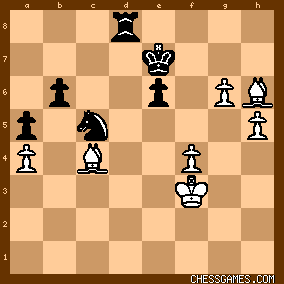
click for larger viewFrom here, white doesn't have to sacrifice his LSB, but his quickest way to win is to run his kingside passers straight away. Would I have played it over the board? Yes, I think so. I don't mind playing an exchange sacrifice if I get something tangible out of it. Two connected and far advanced passed pawns is ample compensation. |
|
| Oct-22-16 | | AlicesKnight: The d6 sacrifice and removal of Black's K-side Ps was easier to see than some Saturday puzzles but it was less clear at first whether this was enough against the possibilities of K and R defence and the removal of the a4 P by the N allowing 2 black passers. But on looking again I'm convinced. |
|
| Oct-22-16 | | SatelliteDan: <easy saturday(?) ... possibly... but how many (as <yourang> suggests) would have the conviction to play the exchange sacrifice OTB(!?)>
I would. |
|
| Oct-22-16 | | weary willy: Yes ... relatively very easy ...solved it with only half a diagram as I scrolled down past the fifth rank, it seemed that there was likely to be a rook on the first three ranks to take the bishop. There was. |
|
Oct-22-16
 | | OhioChessFan: I would, if it comes up in the future. |
|
| Oct-22-16 | | gofer: I don't see this as <Very Difficult>. This is more like a Wednesday
level POTD, than a Saturday. White is two pawns down, so looks to be
losing, but his bishops are about to tear black apart... <36 Rxd6 ...>
36 ... Kxd6
37 Bxe5+ Ke6?
38 Bxg7 Rg8/Rd8?
39 Bxh6 
36 ... e4+
37 Ke3 Kxd6
38 Bxg7 Rg8/Rd8?
39 Be5+ Ke7?
40 f5 
37 Kg4 Kxd6
38 Bxg7 Rg1?
39 Bxh6 
Now there are lots of choices and replies and I have played through most of them,
but too many to be worth discussing, but black really wont be able to hold on... ~~~
Yep. Agreed. It was too easy for a Saturday. |
|
| Oct-22-16 | | agb2002: White has the bishop pair for a bishop, a knight and two pawns. Black threatens exf4, Nxa4, Rf8, etc.
I don't have time today for this puzzle but I think I'd play 36.Rxd6 e4+ 37.Ke3 Kxd6 38.Bxg7 when the very advanced and protected g-pawn virtually leaves Black with two operative pieces against three. For example, 38... Rc8 39.Bxa6 Nxa4 40.Bf8+ Rxf8 41.g7 followed by h6, etc. |
|
| Oct-22-16 | | mel gibson: It was a bold sacrifice that I saw but discounted as too dangerous.
I was wrong. |
|
| Oct-22-16 | | newzild: Like <yadasampati> I found this to be one of the easiest puzzles of the week. To me it seems obvious almost without calculation that the position after 36. Rxd6 Kxd6 37. Bxe5+ followed by 38. Bxg7 is winning for White. It's not even a sacrifice! |
|
| Oct-22-16 | | mel gibson: < Like <yadasampati> I found this to be one of the easiest puzzles of the week. To me it seems obvious almost without calculation that the position after 36. Rxd6 Kxd6 37. Bxe5+ followed by 38. Bxg7 is winning for White. It's not even a sacrifice!> You're wrong.
It is a sacrifice.
DR4 64 bit gives the score for
36.Rxd6 as
+1.36 depth 23.
That's little more than a 1 pawn advantage.
Because black plays better moves on the computer. |
|
| Oct-22-16 | | et1: Easy, it felt like a Tuesday. |
|
Oct-22-16
 | | steinitzfan: I think I got this one. At least my guesses for the first few moves were correct. Unlike most weekend puzzles, the tactical idea here is fairly easy to see. Confirming the soundness of it is -- well let's just say it's a chore. |
|
| Oct-22-16 | | schachfuchs: Yes easy, not even medium. And I would have played it OTB. There is hardly another chance for white to play for a win on move 36. |
|
| Oct-22-16 | | Cheapo by the Dozen: Terrible puzzle. The first few moves are obvious, and should be played whether or not one can see through to the rest of the technique for winning, e.g. the bishop sacrifice on c4. I don't immediately see why Black didn't interpolate ... e4+, but that's a separate and unimportant matter. |
|
| Oct-22-16 | | RandomVisitor: After 23...Nc7
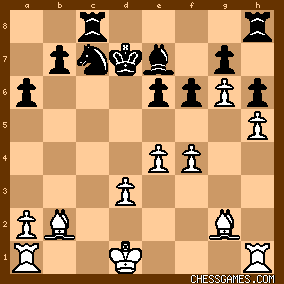
click for larger viewKomodo-10.1-64bit:
<+1.15/36 24.e5> f5 25.a4 b5 26.axb5 Nxb5 27.Rxa6 Rhd8 28.Rb6 Rb8 29.Bb7 Kc7 30.Rxb5 Rxb7 31.Rxb7+ Kxb7 32.Ke2 Ra8 33.Rb1 Ra2 34.Kf3 Kc7 35.Bd4 Ra3 36.Ke3 Ra2 37.Rb6 Ra4 38.Rb2 Kc6 39.Rc2+ Kd7 40.Bc5 Bxc5+ 41.Rxc5 Ra1 42.Rc4 Re1+ 43.Kd2 Rh1 44.Ra4 Rxh5 45.Ra7+ Kc6 46.Rxg7 Rh2+ 47.Kc3 Rg2 48.Rg8 h5 49.g7 After 29.Rd1
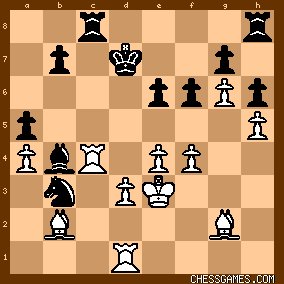
click for larger viewKomodo-10.1-64bit:
<-0.20/50 29...Rxc4> 30.dxc4+ Kc7 31.Bh3 Re8 32.Bg4 Nc5 33.Ra1 Rb8 34.Bf3 Rd8 35.Rd1 Re8 36.Ra1 b6 37.Be2 Rg8 38.Bf3 Rh8 39.Be2 Rd8 40.Rd1 Rc8 41.Ra1 Re8 42.Bg4 Kb7 43.Bf3 Kc8 44.Be2 Rg8 45.Bf3 Rd8 46.Rd1 Rf8 47.Ra1 Rg8 48.Be2 Rd8 49.Rd1 Rf8 50.Ra1 Re8 51.Bf3 Kb8 52.Be2 Rf8 53.Bg4 Kc7 54.Be2 Rb8 55.Bf3 Rd8 56.Rd1 After 33.Kf3
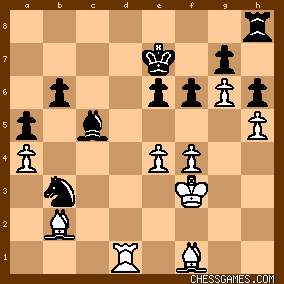
click for larger viewKomodo-10.1-64bit:
<+0.24/40 33...Bb4> 34.Bb5 Nd2+ 35.Ke3 Rd8 36.Bd4 Rd6 37.e5 fxe5 38.Bxe5 Nc4+ 39.Bxc4 Rxd1 40.Bxg7 Rc1 41.Kd3 Rh1 42.Bxh6 Rxh5 43.g7 Rh3+ 44.Ke2 Rg3 45.Kf2 Rg4 46.Bg5+ Rxg5 47.fxg5 Kf7 48.Bxe6+ Kxg7 49.Kf3 Kg6 50.Kg4 Bd2 51.Bf5+ Kf7 52.Be4 Ke6 53.Bd3 Be3 54.Bc4+ Ke5 55.Bb5 Bd2 56.Bd3 Bc3 57.Bc4 Bd2 58.Bb5 Ke6 59.Bc6 Bc3 60.Be8 Bd2 61.Bb5 |
|
| Oct-22-16 | | Once: <You're wrong.
It is a sacrifice. >
White gives up a rook for a bishop and two pawns. Most folk would consider that to be an even material exchange (five points vs five points) and hence not a sacrifice. There is also an argument that a move is not a sacrifice if it leads to a simple winning position. For example, it's not a sacrifice if you temporarily give up material but force a quick mate. That one is more debatable. It's one of those occasions when there is more than one definition. It's not so clear whether an accurate evaluation of the puzzle position is a relatively small +1.36. Most humans would look at the connected passed pawns on the kingside and conclude that white's exchange sacrifice was clearly justified. All in all, I'd say that 36. Rxd6 wasn't a sacrifice. The material is balanced and white has gained connected and far advanced passers. |
|
| Oct-22-16 | | JASAHA: The exchange of a R for B and 2p is worth more than meets the materialist eye. White's 2 passed pawns (on the 6th) are equal to a R and a promotion is inevitable. |
|
| Oct-22-16 | | Abdel Irada: ∞
This has been a strange week. The puzzles seem to have been getting easier rather than harder, now presenting us on Saturday with a problem rated "Very Difficult" that can be solved trivially with a bit of intuition and a dose of resolve. Of course the key move is a pseudo-sacrifice because White gets more than sufficient compensation, but since he's two pawns down going in, that would not ordinarily be enough to recommend it. However, the pawns White picks up (with gain of tempo) are advanced, connected passers on the g and h files, and that is enough for me. <<+> 36. Rxd6!, e4+ > This zwischenzug seems logical, since otherwise Black simply loses this pawn. <<+> 37. Ke3, Kxd6
38. Be5+, Ke7 >
Black's king can go to various squares, but this is preferable to c6 because it avoids Bb5+, depriving White of the opportunity to defend his a-pawn with tempo, and brings the king closer to the passed pawns to participate in the defense. <<+> 39. Bxg7, Rc8
40. Bxh6  > >
There are still a few hurdles to clear, but White wins if he remembers not to be distracted. The technique is simple: Push the pawns until they can't be stopped, and don't worry about anything Black might do on the queenside. ∞ |
|
Oct-22-16
 | | Sally Simpson: Why all the complaints.
It sounds like you guys have been told you have the afternoon off but want to stay on and work. Yes an easy theme to spot. A pawn will promote, Black will have to give up a Rook to stop it. There maybe better defensive tries but then Black will lose a different way. So onto the last check and 'why does Black not just resign' 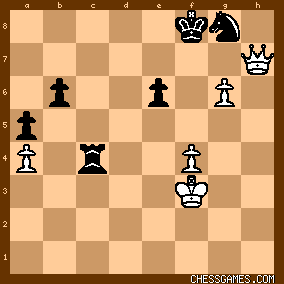
click for larger viewYour wee electronic toy will play the miserable 45...Ke8 here. (these things have no hope.) But here after 45...Rc3+

click for larger viewThe odds are 3-2 in White's favour he will pick the right square to go to. Not good but better odds than playing 45...Ke8
It's down to 50/50 if you do it by ranks and it's against the grain. You have to move away from the centre to avoid the Knight check. Throw in a smug White already working out new grade after a win and you wonder why White never fell for it. :) Those that think no player would ever play 46.Ke4 or 46. Kg4 here have never stubbed their toe on the bathroom door. It's painful and chess history is awash with players going to the wrong square after a 'pointless' check. |
|
| Oct-22-16 | | RandomVisitor: After 36.Rxd6 Kxd6 37.Bxe5+ Ke7 38.Bxg7
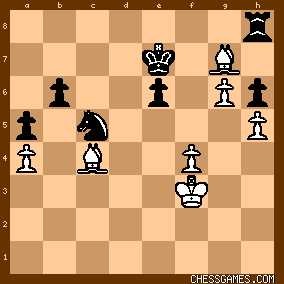
click for larger viewKomodo-10.1-64bit:
<+3.22/43 38...Re8> 39.Bxh6 Kf6 40.Bg5+ Kg7 41.Kg4 Rh8 42.Bh4 Re8 43.Bf2 Ne4 44.Bxb6 Nf6+ 45.Kg5 Rh8 46.Be2 Ne4+ 47.Kh4 Rf8 48.Bc7 Kh6 49.Bg4 Nf6 50.Bxe6 Re8 51.f5 Kg7 52.Bf4 Rh8 53.h6+ Rxh6+ 54.Bxh6+ Kxh6 55.Bc4 Nd7 56.Bb5 Nb6 57.Bc6 Nc4 58.Be4 Nd6 59.Bb1 Ne8 60.Bd3 Kg7 61.Kg5 Nf6 62.Kf4 Nd5+ 63.Ke5 Nf6 64.Bc4 Ng4+ 65.Ke6 Nf6 66.Bd3 Ng4 67.Be2 Nh6 68.Ke5 Ng8 69.Bb5 Nf6 |
|
| Oct-22-16 | | patzer2: For today's Saturday solution, I easily found the first three moves <36.Rxd6! Kxd6 37.Bxe5+ Ke7 38.Bxg7.> However, other than planning to play <39. Bxh7> I found anticipating all of Black's defenses and formulating a specific plan to push the connected passed pawns to be very difficult. As such, I particularly appreciate the comment of <Sally Simpson> in describing the practical difficulties in converting such a position to a win. Though my play is not strong enough to be part of "Chess history," I hate to think of the number of times I've blew a won position by "going to the wrong square." I also appreciate the strong play of GM Jabova and the 43 ply deep Komodo 10.1 analysis provided by <Random Visitor.> Strong GM technique and deep computer analysis often has a way of making difficult technique look easy. |
|
| Oct-22-16 | | lentil: I would not hesitate to play Rxd6; in fact, I would try to impel B to allow it. |
|
| Oct-22-16 | | RandomVisitor: After 36.Rxd6
Komodo-10.1-64bit
+3.75/40 36...Kxd6 37.Bxe5+ Ke7 38.Bxg7 Rc8 39.Bxh6 Kf6 40.Bg5+ Kg7 41.Kg4 Rh8 42.Bh4 Re8 43.Bf2 Ne4 44.Bxb6 Nf6+ 45.Kg5 Ne4+ 46.Kh4 Nd6 47.Bd3 Kh6 48.Bxa5 Rf8 49.Kg4 Nf5 50.Bb6 Ng7 51.Bc5 Re8 52.Be3 Nf5 53.Bb6 Rb8 54.a5 Ng7 55.a6 Nxh5 56.a7 Nf6+ 57.Kf3 Rh8 58.Bd4 Rd8 59.Bc2 Ne8 60.Be3 Kg7 61.Bc5 Nc7 62.Bb6 Ra8 63.Bd4+ Kh6 64.Bd3 e5 65.fxe5 Rf8+ 66.Kg4 Ne6 67.Be3+ Kg7 |
|
| Oct-22-16 | | Mortadulo: The initial move might be obvious sure. I notice a lot of people complaining about it being too easy... There is a difference between finding the first move and proving that it works. |
|
| Oct-22-16 | | morfishine: Straight forward exchange SACRIFICE
Nothing special here today
***** |
|
 |
|
< Earlier Kibitzing · PAGE 2 OF 2 ·
Later Kibitzing> |





